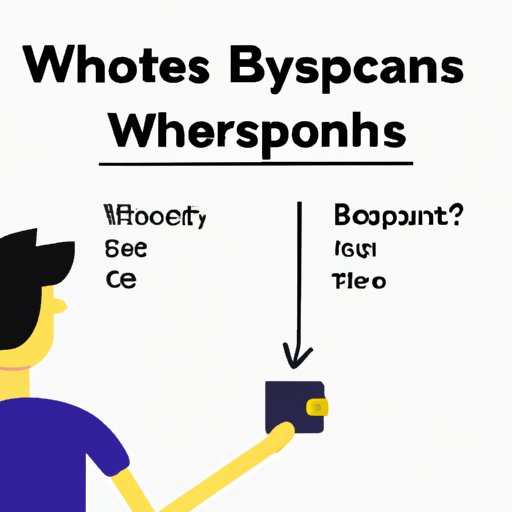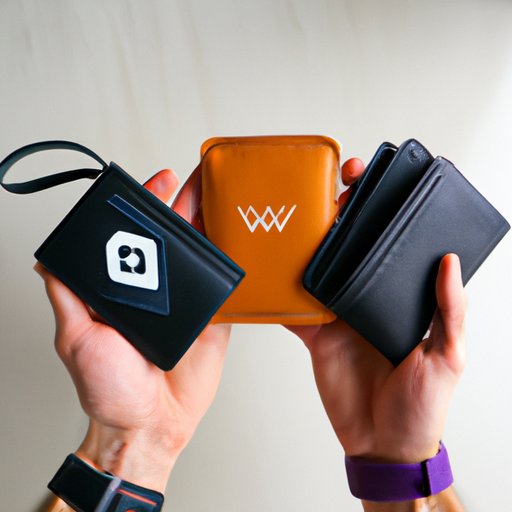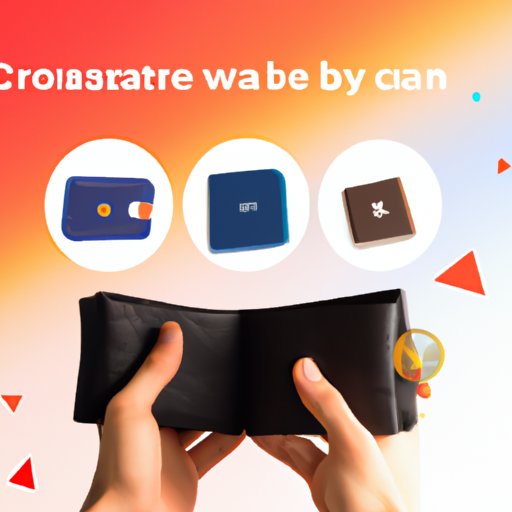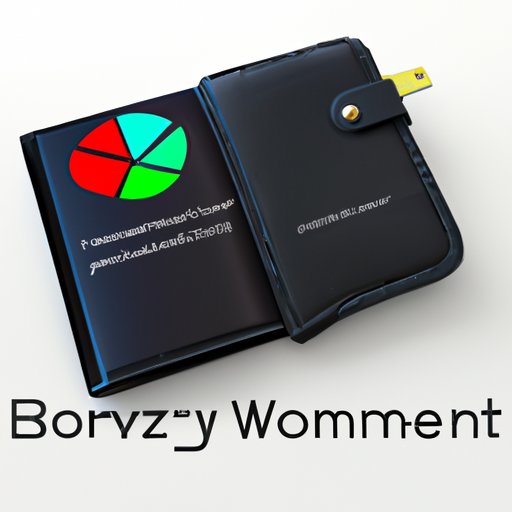Introduction
Cryptocurrency has become an increasingly popular form of digital currency in recent years. As its popularity continues to grow, many people are now looking for ways to store and manage their cryptocurrency. One of the best ways to do this is by using a crypto wallet.
A crypto wallet is a secure digital storage system that allows users to store, send, and receive cryptocurrency. Crypto wallets are designed to be easy to use and provide users with a safe and secure way to store their cryptocurrency. In this article, we will explore how to start a crypto wallet and cover all the basics you need to know.

Explaining the Basics of Cryptocurrency Wallets
Before we dive into how to set up a crypto wallet, it’s important to understand the basics of cryptocurrency wallets. Cryptocurrency wallets are designed to hold digital assets like bitcoin, ethereum, and other cryptocurrencies. They provide users with a way to store, send, and receive digital assets securely.
Cryptocurrency wallets come in a variety of forms, including web wallets, software wallets, and hardware wallets. Each type of wallet offers different features and benefits, so it’s important to understand the differences before you decide which one is right for you.
Different Types of Wallets
There are several different types of crypto wallets available, each with its own set of advantages and disadvantages. The most common types of wallets include web wallets, software wallets, and hardware wallets.
Web wallets are online services that allow users to store their cryptocurrency. They are usually easy to use and offer a variety of features, but they can also be vulnerable to hacking attempts. Software wallets are applications that are installed on your computer or mobile device. They offer better security than web wallets, but they require more effort to set up and maintain. Hardware wallets are physical devices that store your cryptocurrency offline, providing the highest level of security. However, they can be difficult to set up and maintain.
How Wallets Store Cryptocurrency
Cryptocurrency wallets store cryptocurrency in two ways: public keys and private keys. Public keys are used to identify your wallet address, while private keys are used to access and move your funds. When you create a wallet, you will be given a unique public key and a private key. It’s important to keep your private key secure, as anyone who has access to it can access your funds.
Step-by-Step Guide to Setting Up a Crypto Wallet
Now that you understand the basics of cryptocurrency wallets, let’s take a look at how to set up a crypto wallet. Setting up a wallet isn’t difficult, but it does require some steps to ensure that your wallet is secure and ready to use.
Choosing a Provider
The first step in setting up a crypto wallet is choosing a provider. There are many different providers available, so it’s important to do your research and choose one that meets your needs. Look for a provider that offers the features you need and has a good reputation for security and customer service.
Downloading and Installing the Wallet
Once you’ve chosen a provider, you’ll need to download and install the wallet. This process varies depending on the type of wallet you’re using, but most wallets can be downloaded from the provider’s website. Once you’ve downloaded the wallet, follow the instructions to install it on your computer or mobile device.
Securing the Wallet
The next step is to secure your wallet. Most wallets will require you to create a strong password and set up two-factor authentication. It’s important to choose a strong password and keep it safe, as anyone who has access to it can access your funds. You should also enable two-factor authentication, which adds an extra layer of security to your wallet.
Adding Funds to the Wallet
Once you’ve secured your wallet, you’re ready to add funds to it. Depending on the type of wallet you’re using, there may be different ways to add funds. Some wallets allow you to buy cryptocurrency directly from the wallet, while others require you to transfer funds from another wallet or exchange. Make sure you read the instructions carefully before adding funds to your wallet.

Comparing Different Types of Crypto Wallets
Now that you understand the basics of how to set up a crypto wallet, let’s take a look at the different types of wallets and compare their features. This will help you decide which type of wallet is best for your needs.
Hot Wallets vs Cold Wallets
The main difference between hot wallets and cold wallets is how they store your cryptocurrency. Hot wallets store your cryptocurrency online, making them easier to access but less secure. Cold wallets store your cryptocurrency offline, making them more secure but harder to access.
Desktop Wallets vs Mobile Wallets
Desktop wallets are applications that are installed on your computer. They offer more features and better security than mobile wallets, but they can be difficult to set up and maintain. Mobile wallets are apps that are installed on your phone or tablet. They are easier to set up and use, but they have fewer features and may not be as secure as desktop wallets.
Online Wallets vs Hardware Wallets
Online wallets are web-based services that you can access from any internet-connected device. They are easy to use and offer a variety of features, but they can be vulnerable to hacking attempts. Hardware wallets are physical devices that store your cryptocurrency offline. They offer the highest level of security, but they can be difficult to set up and maintain.

Choosing the Best Crypto Wallet for Your Needs
When choosing a crypto wallet, it’s important to consider your security needs, ease of use, and whether you want hot or cold storage. Here are some tips to help you make the best decision.
Consider Your Security Needs
Security should be your top priority when choosing a crypto wallet. Consider the type of wallet you’re using and the security features it offers. For example, hardware wallets offer the highest level of security, but they can be difficult to set up and maintain. Web wallets are easy to use but can be vulnerable to hacking attempts.
Think About Ease of Use
It’s also important to think about how easy the wallet is to use. If you’re new to cryptocurrency, you may want to opt for a wallet that’s easy to set up and use, such as a web wallet or mobile wallet. More experienced users may want to opt for a wallet that offers more features and better security, such as a desktop wallet or hardware wallet.
Decide Between Hot and Cold Storage
Finally, you’ll need to decide between hot and cold storage. Hot wallets store your cryptocurrency online, making them easier to access but less secure. Cold wallets store your cryptocurrency offline, making them more secure but harder to access. Consider your needs and choose the option that best suits you.
Tips for Keeping Your Crypto Wallet Secure
Once you’ve chosen a wallet and added funds to it, it’s important to keep it secure. Here are some tips to help you protect your wallet and your funds.
Use Strong Passwords
Always use a strong password for your wallet. Choose a password that is at least eight characters long and includes a combination of letters, numbers, and symbols. It’s also important to change your password regularly to reduce the risk of someone guessing it.
Keep Your Private Keys Safe
Your private keys are what give you access to your funds, so it’s important to keep them safe. Never share your private keys with anyone, and make sure you back them up in case you ever lose access to your wallet.
Use Two-Factor Authentication
Two-factor authentication (2FA) is an additional layer of security that requires you to enter a code sent to your phone or email when logging into your wallet. This helps prevent unauthorized access to your wallet, even if someone gets access to your username and password.
Only Access Trusted Sites
It’s also important to only access trusted websites when accessing your wallet or making transactions. Be wary of sites offering “free” cryptocurrency or promising large returns, as these may be scams. Only access sites that you trust and never enter your private keys on a site you don’t recognize.
How to Transfer Funds to and from a Crypto Wallet
Once you’ve set up your wallet and added funds to it, you’ll need to know how to transfer funds to and from it. Here’s a quick overview of how to do it.
Sending Funds
To send funds from your wallet, you’ll need to enter the recipient’s wallet address, the amount you want to send, and any additional information required. Once you’ve entered this information, confirm the transaction and wait for it to be processed.
Receiving Funds
To receive funds in your wallet, you’ll need to provide the sender with your wallet address. Once the sender has entered your address, the funds will be sent to your wallet. You can then check your wallet balance to see if the funds have been received.
Troubleshooting Common Crypto Wallet Problems
Crypto wallets can sometimes encounter problems, such as incorrect or lost private keys, unauthorized transactions, and inaccessible funds. Here are some tips for troubleshooting common crypto wallet problems.
Incorrect or Lost Private Keys
If you’ve lost or forgotten your private keys, you won’t be able to access your funds. To recover your funds, contact your wallet provider and explain the situation. The provider may be able to help you regain access to your wallet.
Unauthorized Transactions
If you notice any unauthorized transactions in your wallet, contact your wallet provider immediately. The provider will be able to investigate the transaction and help you recover any funds that were stolen.
Inaccessible Funds
If you’re unable to access your funds, make sure you’ve entered the correct wallet address and that the transaction has been confirmed. If the problem persists, contact your wallet provider for assistance.
Conclusion
Crypto wallets are a convenient and secure way to store, send, and receive cryptocurrency. Setting up a wallet isn’t difficult, but it’s important to understand the basics before you get started. This article has provided a comprehensive guide to setting up a crypto wallet, from choosing a provider to troubleshooting common problems.
(Note: Is this article not meeting your expectations? Do you have knowledge or insights to share? Unlock new opportunities and expand your reach by joining our authors team. Click Registration to join us and share your expertise with our readers.)
